Yating Wang
Learning Primitive Embodied World Models: Towards Scalable Robotic Learning
Aug 28, 2025

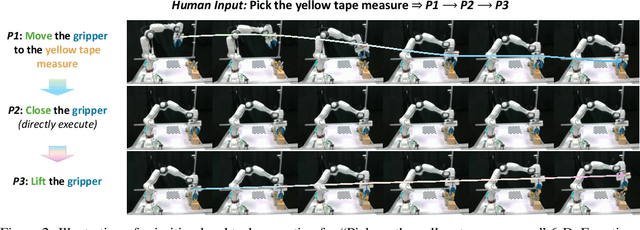

Abstract:While video-generation-based embodied world models have gained increasing attention, their reliance on large-scale embodied interaction data remains a key bottleneck. The scarcity, difficulty of collection, and high dimensionality of embodied data fundamentally limit the alignment granularity between language and actions and exacerbate the challenge of long-horizon video generation--hindering generative models from achieving a "GPT moment" in the embodied domain. There is a naive observation: the diversity of embodied data far exceeds the relatively small space of possible primitive motions. Based on this insight, we propose a novel paradigm for world modeling--Primitive Embodied World Models (PEWM). By restricting video generation to fixed short horizons, our approach 1) enables fine-grained alignment between linguistic concepts and visual representations of robotic actions, 2) reduces learning complexity, 3) improves data efficiency in embodied data collection, and 4) decreases inference latency. By equipping with a modular Vision-Language Model (VLM) planner and a Start-Goal heatmap Guidance mechanism (SGG), PEWM further enables flexible closed-loop control and supports compositional generalization of primitive-level policies over extended, complex tasks. Our framework leverages the spatiotemporal vision priors in video models and the semantic awareness of VLMs to bridge the gap between fine-grained physical interaction and high-level reasoning, paving the way toward scalable, interpretable, and general-purpose embodied intelligence.
VQ-VLA: Improving Vision-Language-Action Models via Scaling Vector-Quantized Action Tokenizers
Jul 01, 2025Abstract:In this paper, we introduce an innovative vector quantization based action tokenizer built upon the largest-scale action trajectory dataset to date, leveraging over 100 times more data than previous approaches. This extensive dataset enables our tokenizer to capture rich spatiotemporal dynamics, resulting in a model that not only accelerates inference but also generates smoother and more coherent action outputs. Once trained, the tokenizer can be seamlessly adapted to a wide range of downstream tasks in a zero-shot manner, from short-horizon reactive behaviors to long-horizon planning. A key finding of our work is that the domain gap between synthetic and real action trajectories is marginal, allowing us to effectively utilize a vast amount of synthetic data during training without compromising real-world performance. To validate our approach, we conducted extensive experiments in both simulated environments and on real robotic platforms. The results demonstrate that as the volume of synthetic trajectory data increases, the performance of our tokenizer on downstream tasks improves significantly-most notably, achieving up to a 30% higher success rate on two real-world tasks in long-horizon scenarios. These findings highlight the potential of our action tokenizer as a robust and scalable solution for real-time embodied intelligence systems, paving the way for more efficient and reliable robotic control in diverse application domains.Project website: https://xiaoxiao0406.github.io/vqvla.github.io
MinosEval: Distinguishing Factoid and Non-Factoid for Tailored Open-Ended QA Evaluation with LLMs
Jun 18, 2025Abstract:Open-ended question answering (QA) is a key task for evaluating the capabilities of large language models (LLMs). Compared to closed-ended QA, it demands longer answer statements, more nuanced reasoning processes, and diverse expressions, making refined and interpretable automatic evaluation both crucial and challenging. Traditional metrics like ROUGE and BERTScore struggle to capture semantic similarities due to different patterns between model responses and reference answers. Current LLM-based evaluation approaches, such as pairwise or listwise comparisons of candidate answers, lack intuitive interpretability. While pointwise scoring of each response provides some descriptions, it fails to adapt across different question contents. Most notably, existing methods overlook the distinction between factoid and non-factoid questions. To address these challenges, we propose \textbf{MinosEval}, a novel evaluation method that first distinguishes open-ended questions and then ranks candidate answers using different evaluation strategies. For factoid questions, it applies an adaptive key-point scoring strategy, while for non-factoid questions, it uses an instance-aware listwise ranking strategy. Experiments on multiple open-ended QA datasets, including self-built ones with more candidate responses to complement community resources, show that MinosEval better aligns with human annotations and offers more interpretable results.
CoMo: Learning Continuous Latent Motion from Internet Videos for Scalable Robot Learning
May 22, 2025Abstract:Learning latent motion from Internet videos is crucial for building generalist robots. However, existing discrete latent action methods suffer from information loss and struggle with complex and fine-grained dynamics. We propose CoMo, which aims to learn more informative continuous motion representations from diverse, internet-scale videos. CoMo employs a early temporal feature difference mechanism to prevent model collapse and suppress static appearance noise, effectively discouraging shortcut learning problem. Furthermore, guided by the information bottleneck principle, we constrain the latent motion embedding dimensionality to achieve a better balance between retaining sufficient action-relevant information and minimizing the inclusion of action-irrelevant appearance noise. Additionally, we also introduce two new metrics for more robustly and affordably evaluating motion and guiding motion learning methods development: (i) the linear probing MSE of action prediction, and (ii) the cosine similarity between past-to-current and future-to-current motion embeddings. Critically, CoMo exhibits strong zero-shot generalization, enabling it to generate continuous pseudo actions for previously unseen video domains. This capability facilitates unified policy joint learning using pseudo actions derived from various action-less video datasets (such as cross-embodiment videos and, notably, human demonstration videos), potentially augmented with limited labeled robot data. Extensive experiments show that policies co-trained with CoMo pseudo actions achieve superior performance with both diffusion and autoregressive architectures in simulated and real-world settings.
3D Gaussian Head Avatars with Expressive Dynamic Appearances by Compact Tensorial Representations
Apr 21, 2025Abstract:Recent studies have combined 3D Gaussian and 3D Morphable Models (3DMM) to construct high-quality 3D head avatars. In this line of research, existing methods either fail to capture the dynamic textures or incur significant overhead in terms of runtime speed or storage space. To this end, we propose a novel method that addresses all the aforementioned demands. In specific, we introduce an expressive and compact representation that encodes texture-related attributes of the 3D Gaussians in the tensorial format. We store appearance of neutral expression in static tri-planes, and represents dynamic texture details for different expressions using lightweight 1D feature lines, which are then decoded into opacity offset relative to the neutral face. We further propose adaptive truncated opacity penalty and class-balanced sampling to improve generalization across different expressions. Experiments show this design enables accurate face dynamic details capturing while maintains real-time rendering and significantly reduces storage costs, thus broadening the applicability to more scenarios.
Tra-MoE: Learning Trajectory Prediction Model from Multiple Domains for Adaptive Policy Conditioning
Nov 21, 2024



Abstract:Learning from multiple domains is a primary factor that influences the generalization of a single unified robot system. In this paper, we aim to learn the trajectory prediction model by using broad out-of-domain data to improve its performance and generalization ability. Trajectory model is designed to predict any-point trajectories in the current frame given an instruction and can provide detailed control guidance for robotic policy learning. To handle the diverse out-of-domain data distribution, we propose a sparsely-gated MoE (\textbf{Top-1} gating strategy) architecture for trajectory model, coined as \textbf{Tra-MoE}. The sparse activation design enables good balance between parameter cooperation and specialization, effectively benefiting from large-scale out-of-domain data while maintaining constant FLOPs per token. In addition, we further introduce an adaptive policy conditioning technique by learning 2D mask representations for predicted trajectories, which is explicitly aligned with image observations to guide action prediction more flexibly. We perform extensive experiments on both simulation and real-world scenarios to verify the effectiveness of Tra-MoE and adaptive policy conditioning technique. We also conduct a comprehensive empirical study to train Tra-MoE, demonstrating that our Tra-MoE consistently exhibits superior performance compared to the dense baseline model, even when the latter is scaled to match Tra-MoE's parameter count.
Textual Decomposition Then Sub-motion-space Scattering for Open-Vocabulary Motion Generation
Nov 06, 2024



Abstract:Text-to-motion generation is a crucial task in computer vision, which generates the target 3D motion by the given text. The existing annotated datasets are limited in scale, resulting in most existing methods overfitting to the small datasets and unable to generalize to the motions of the open domain. Some methods attempt to solve the open-vocabulary motion generation problem by aligning to the CLIP space or using the Pretrain-then-Finetuning paradigm. However, the current annotated dataset's limited scale only allows them to achieve mapping from sub-text-space to sub-motion-space, instead of mapping between full-text-space and full-motion-space (full mapping), which is the key to attaining open-vocabulary motion generation. To this end, this paper proposes to leverage the atomic motion (simple body part motions over a short time period) as an intermediate representation, and leverage two orderly coupled steps, i.e., Textual Decomposition and Sub-motion-space Scattering, to address the full mapping problem. For Textual Decomposition, we design a fine-grained description conversion algorithm, and combine it with the generalization ability of a large language model to convert any given motion text into atomic texts. Sub-motion-space Scattering learns the compositional process from atomic motions to the target motions, to make the learned sub-motion-space scattered to form the full-motion-space. For a given motion of the open domain, it transforms the extrapolation into interpolation and thereby significantly improves generalization. Our network, $DSO$-Net, combines textual $d$ecomposition and sub-motion-space $s$cattering to solve the $o$pen-vocabulary motion generation. Extensive experiments demonstrate that our DSO-Net achieves significant improvements over the state-of-the-art methods on open-vocabulary motion generation. Code is available at https://vankouf.github.io/DSONet/.
SPA: 3D Spatial-Awareness Enables Effective Embodied Representation
Oct 10, 2024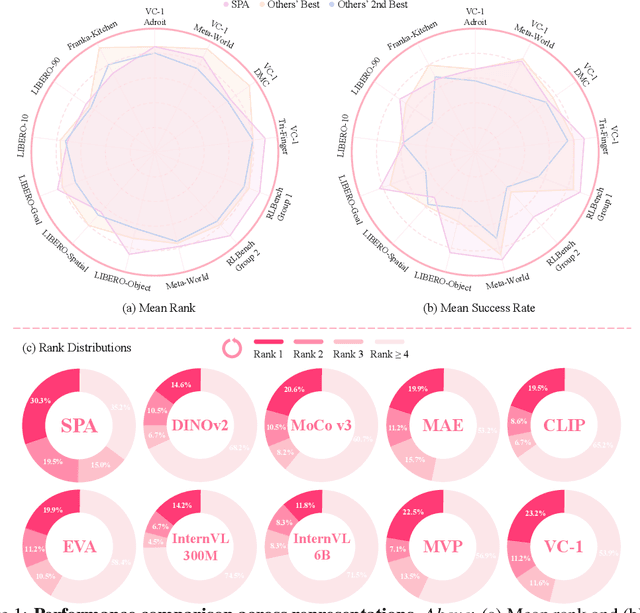
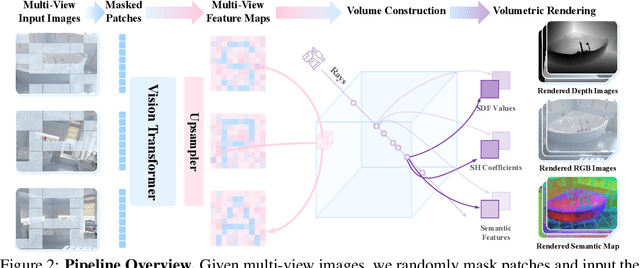

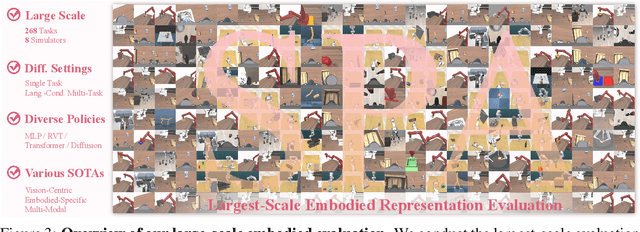
Abstract:In this paper, we introduce SPA, a novel representation learning framework that emphasizes the importance of 3D spatial awareness in embodied AI. Our approach leverages differentiable neural rendering on multi-view images to endow a vanilla Vision Transformer (ViT) with intrinsic spatial understanding. We present the most comprehensive evaluation of embodied representation learning to date, covering 268 tasks across 8 simulators with diverse policies in both single-task and language-conditioned multi-task scenarios. The results are compelling: SPA consistently outperforms more than 10 state-of-the-art representation methods, including those specifically designed for embodied AI, vision-centric tasks, and multi-modal applications, while using less training data. Furthermore, we conduct a series of real-world experiments to confirm its effectiveness in practical scenarios. These results highlight the critical role of 3D spatial awareness for embodied representation learning. Our strongest model takes more than 6000 GPU hours to train and we are committed to open-sourcing all code and model weights to foster future research in embodied representation learning. Project Page: https://haoyizhu.github.io/spa/.
Portrait3D: 3D Head Generation from Single In-the-wild Portrait Image
Jun 24, 2024Abstract:While recent works have achieved great success on one-shot 3D common object generation, high quality and fidelity 3D head generation from a single image remains a great challenge. Previous text-based methods for generating 3D heads were limited by text descriptions and image-based methods struggled to produce high-quality head geometry. To handle this challenging problem, we propose a novel framework, Portrait3D, to generate high-quality 3D heads while preserving their identities. Our work incorporates the identity information of the portrait image into three parts: 1) geometry initialization, 2) geometry sculpting, and 3) texture generation stages. Given a reference portrait image, we first align the identity features with text features to realize ID-aware guidance enhancement, which contains the control signals representing the face information. We then use the canny map, ID features of the portrait image, and a pre-trained text-to-normal/depth diffusion model to generate ID-aware geometry supervision, and 3D-GAN inversion is employed to generate ID-aware geometry initialization. Furthermore, with the ability to inject identity information into 3D head generation, we use ID-aware guidance to calculate ID-aware Score Distillation (ISD) for geometry sculpting. For texture generation, we adopt the ID Consistent Texture Inpainting and Refinement which progressively expands the view for texture inpainting to obtain an initialization UV texture map. We then use the id-aware guidance to provide image-level supervision for noisy multi-view images to obtain a refined texture map. Extensive experiments demonstrate that we can generate high-quality 3D heads with accurate geometry and texture from single in-the-wild portrait images. The project page is at https://jinkun-hao.github.io/Portrait3D/.
DGRC: An Effective Fine-tuning Framework for Distractor Generation in Chinese Multi-choice Reading Comprehension
May 29, 2024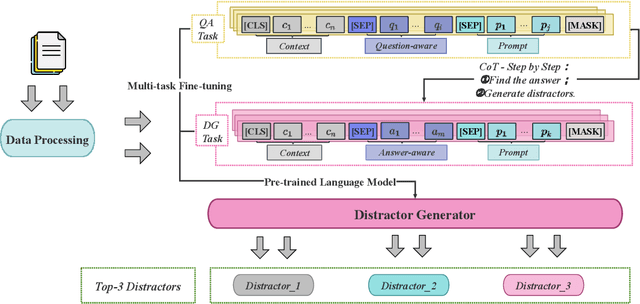
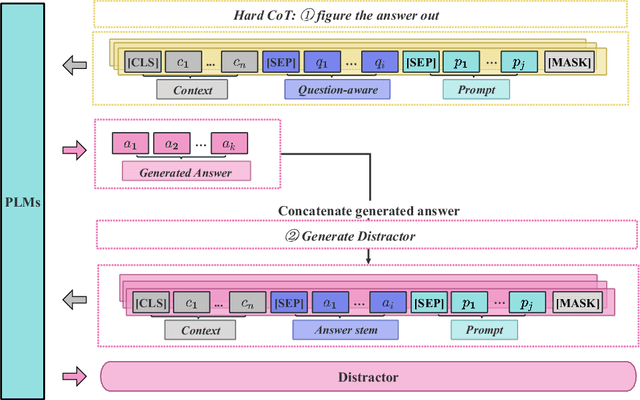
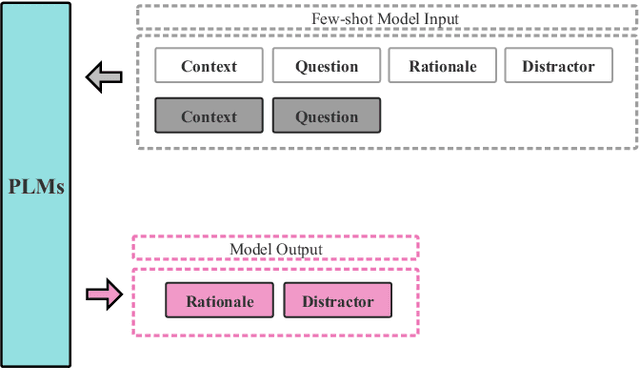
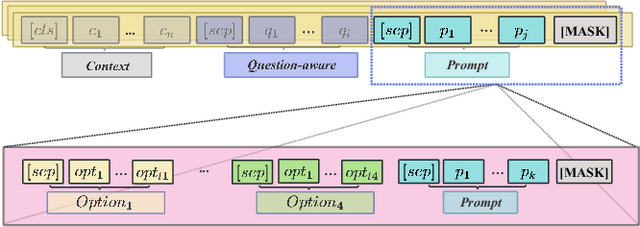
Abstract:When evaluating a learner's knowledge proficiency, the multiple-choice question is an efficient and widely used format in standardized tests. Nevertheless, generating these questions, particularly plausible distractors (incorrect options), poses a considerable challenge. Generally, the distractor generation can be classified into cloze-style distractor generation (CDG) and natural questions distractor generation (NQDG). In contrast to the CDG, utilizing pre-trained language models (PLMs) for NQDG presents three primary challenges: (1) PLMs are typically trained to generate ``correct'' content, like answers, while rarely trained to generate ``plausible" content, like distractors; (2) PLMs often struggle to produce content that aligns well with specific knowledge and the style of exams; (3) NQDG necessitates the model to produce longer, context-sensitive, and question-relevant distractors. In this study, we introduce a fine-tuning framework named DGRC for NQDG in Chinese multi-choice reading comprehension from authentic examinations. DGRC comprises three major components: hard chain-of-thought, multi-task learning, and generation mask patterns. The experiment results demonstrate that DGRC significantly enhances generation performance, achieving a more than 2.5-fold improvement in BLEU scores.
 Add to Chrome
Add to Chrome Add to Firefox
Add to Firefox Add to Edge
Add to Edge